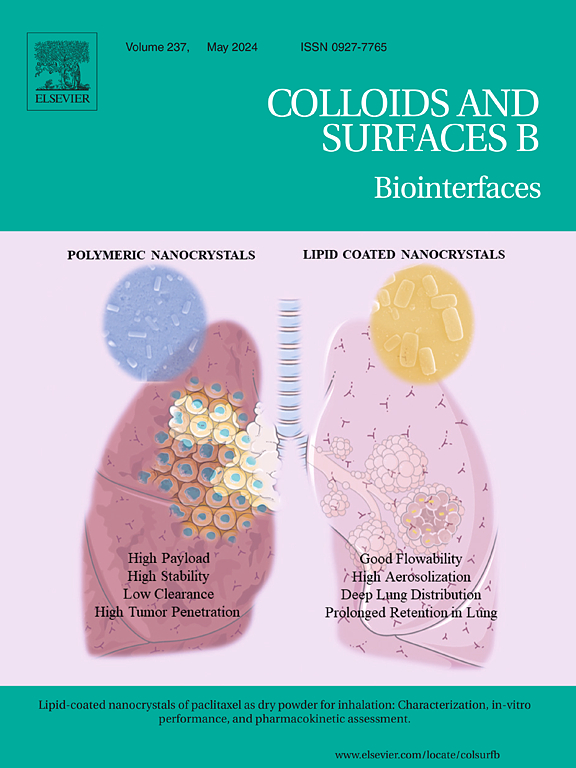Metformin loaded Mn3O4@SiO2 core–shell nanoparticles for glioblastoma multiforme targeted therapy
IF 5.4
2区 医学
Q1 BIOPHYSICS
引用次数: 0
Abstract
Glioblastoma multiforme (GBM) presents unique challenges that contribute to a poor early-stage prognosis, primarily due to the difficulty of chemotherapy drugs face in crossing the blood-brain barrier (BBB). Despite decades of research, overall survival rates for GBM patients remain low. However, modified nanoscale biomaterials show promise in enhancing drug delivery and efficacy by effectively penetrating the BBB. In this study, we developed metformin (MET)-loaded Mn₃O₄@SiO₂@cRGD nanoparticles (MSMC NPs) as a targeted pH-responsive drug delivery system for treating glioblastoma (GBM). The nanoparticles demonstrated a high drug-loading capacity of 69.4 ± 3.7 % and an encapsulation efficiency of 11.5 ± 2.1 %. In vitro studies showed that MSMC NPs significantly enhanced cellular uptake in U251 and U87 GBM cells, with a 2.5-fold increase in fluorescence intensity compared to non-targeted nanoparticles. The pH-responsive release of MET reached 70 % at pH 5.5, compared to only 30 % at pH 7.4 over 48 hours. MSMC NPs resulted in a 55.6 % reduction in U251 cell viability and a 43.4 % decrease in U87 cell viability at a 15 mM MET concentration, significantly outperforming free MET. Furthermore, the nanoparticles inhibited cell migration by 80 % in a 3D spheroid model and increased apoptosis rates by 40 % in U251 cells and 35 % in U87 cells. These findings highlight the potential of MSMC NPs as a targeted, pH-responsive, and theranostic platform for improving GBM treatment by enhancing drug delivery and minimizing off-target effects. This study establishes a foundation for developing Mn₃O₄-based nanomedicines for precise cancer therapy.
二甲双胍负载Mn3O4@SiO2核壳纳米颗粒用于胶质母细胞瘤多形性靶向治疗
多形性胶质母细胞瘤(GBM)具有独特的挑战,导致早期预后不佳,主要是由于化疗药物难以通过血脑屏障(BBB)。尽管经过几十年的研究,GBM患者的总体存活率仍然很低。然而,改性的纳米级生物材料显示出通过有效穿透血脑屏障来增强药物传递和疗效的前景。在这项研究中,我们开发了二甲双胍(MET)负载的Mn₃O₄@SiO₂@cRGD纳米颗粒(MSMC NPs)作为治疗胶质母细胞瘤(GBM)的靶向ph反应药物递送系统。纳米颗粒的载药量为69.4 ± 3.7 %,包封率为11.5 ± 2.1 %。体外研究表明,MSMC NPs显著增强了U251和U87 GBM细胞的细胞摄取,与非靶向纳米颗粒相比,荧光强度增加了2.5倍。在pH值为5.5时,MET的pH响应释放量达到70% %,而在pH值为7.4时,在48 小时内MET的pH响应释放量仅为30% %。在15 mM MET浓度下,MSMC NPs导致U251细胞活力降低55.6% %,U87细胞活力降低43.4% %,显著优于游离MET。此外,在三维球体模型中,纳米颗粒抑制细胞迁移80 %,并使U251细胞的凋亡率提高40 %,U87细胞的凋亡率提高35 %。这些发现强调了MSMC NPs作为一种靶向性、ph反应性和治疗平台的潜力,通过增强药物传递和最小化脱靶效应来改善GBM治疗。该研究为开发用于癌症精确治疗的Mn₃O₄纳米药物奠定了基础。
本文章由计算机程序翻译,如有差异,请以英文原文为准。
求助全文
约1分钟内获得全文
求助全文
来源期刊

Colloids and Surfaces B: Biointerfaces
生物-材料科学:生物材料
CiteScore
11.10
自引率
3.40%
发文量
730
审稿时长
42 days
期刊介绍:
Colloids and Surfaces B: Biointerfaces is an international journal devoted to fundamental and applied research on colloid and interfacial phenomena in relation to systems of biological origin, having particular relevance to the medical, pharmaceutical, biotechnological, food and cosmetic fields.
Submissions that: (1) deal solely with biological phenomena and do not describe the physico-chemical or colloid-chemical background and/or mechanism of the phenomena, and (2) deal solely with colloid/interfacial phenomena and do not have appropriate biological content or relevance, are outside the scope of the journal and will not be considered for publication.
The journal publishes regular research papers, reviews, short communications and invited perspective articles, called BioInterface Perspectives. The BioInterface Perspective provide researchers the opportunity to review their own work, as well as provide insight into the work of others that inspired and influenced the author. Regular articles should have a maximum total length of 6,000 words. In addition, a (combined) maximum of 8 normal-sized figures and/or tables is allowed (so for instance 3 tables and 5 figures). For multiple-panel figures each set of two panels equates to one figure. Short communications should not exceed half of the above. It is required to give on the article cover page a short statistical summary of the article listing the total number of words and tables/figures.
 求助内容:
求助内容: 应助结果提醒方式:
应助结果提醒方式:


